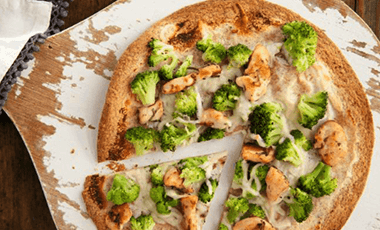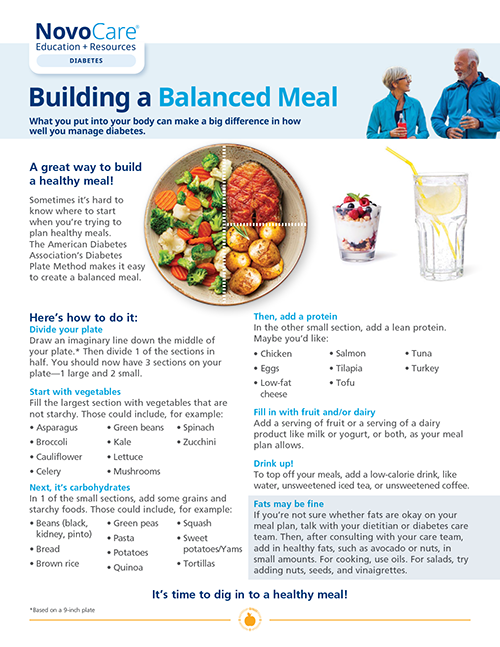
EATING
So, what can I eat?

See how to keep making diabetes‑friendly food choices that you actually enjoy.
Making healthy food choices is an important part of managing your diabetes. Not sure where to start? Here, you'll see:
- Some of the foods you should eat, and some that you should keep off your plate
- The difference between good fats and bad fats
- Why eating more fruits and vegetables is smart
The more you learn about your food choices, the easier it will be to make healthy eating a delicious part of managing your diabetes.
Where do you begin?
Eating healthy with diabetes is about more than just carbCarbohydrateCarbohydrates are the main kinds of food that raise blood glucose levels. Your digestive system changes carbohydrates into glucose, and then uses this glucose as a source of energy for your cells.
There are 3 main types of carbohydrates in food: starches (complex carbohydrates), sugars (simple carbohydrates), and fiber. Fiber is the part of plant foods, including fruits, vegetables, and nuts, that you can’t digest. counting. You'll also need to make some other healthy food choices. Remember, it is important to discuss your meal plan and food choices with your diabetes care teamDiabetes care teamYour diabetes care team may include a primary care doctor, a diabetes and hormone doctor (endocrinologist), a registered nurse, a diabetes educator, a dietitian, a heart doctor (cardiologist), a foot doctor (podiatrist), an eye doctor (ophthalmologist/optometrist), a kidney doctor (nephrologist), a dentist, a pharmacist, and a mental health professional. .

Eat more fiber
Fiber can’t be digested, so it helps “clean out” your digestive system. It also helps you feel full after eating and may lower cholesterol levels. Try whole-grain breads and cereals, as well as fresh fruits and vegetables.

Eat more fresh fruits and vegetables
Choose a colorful variety of fruits and vegetables. That will help you reach your daily intake of important nutrients that sometimes get overlooked. Try using more fresh or frozen blueberries, spinach, broccoli, oranges, cantaloupe, sweet potatoes, and red bell pepper in your meals or as a snack. Remember, some fruits are high in carbs. Low-sugar choices like strawberries, blackberries, and raspberries also make great options.

Choose foods with "good" (unsaturated) fats
Choose oils high in monounsaturated fats such as canola, olive, and peanut, or oils high in polyunsaturated fats like corn, sunflower, and safflower. Food sources of healthy fats also include nuts, olives, flax seeds, avocados, and fish naturally high in omega-3 fats such as salmon, mackerel, herring, and sardines.

Avoid foods with "bad" (saturated and trans) fats
Saturated fats are found in food made from animal sources such as fatty meats, butter, cheese, whole milk as well as tropical oils (palm oil and coconut oil). Trans fats are formed after a chemical process changes a liquid fat (oil) into a solid fat. Trans fats are commonly found in some margarines and fat products used in cookies and a variety of other processed foods. Check the food label to see how much saturated and trans fat the food contains.

Enjoy foods that are grilled, baked, or broiled. Eat fewer fried foods
Bake, broil, or grill using very little added fat. Use a quick spray of a healthier oil such as canola or olive oil to keep food from sticking to the pan, or to add flavor.

Eat less salt and foods containing sodium
Lower the amount of sodium-containing foods like table salt, processed foods such as deli meats, canned soups and stews, salted snack foods (salted crackers, pretzels, nuts), cheese, and prepared foods. Rinsing canned foods can help reduce the amount of sodium in the food by one-half to three-quarters.
Test your knowledge
You have to give up chocolate if you have diabetes.
Correct!
Sorry, that's incorrect.
But moderation is the key to success, so you shouldn’t overindulge. Many people find that limiting it to a square or two can satisfy the urge without going overboard. Also, think about trying dark chocolate instead of milk chocolate. Dark chocolate usually has less sugar. Look for at least 70% cocoa or more. And avoid chocolate that has other sweets like caramel added.



